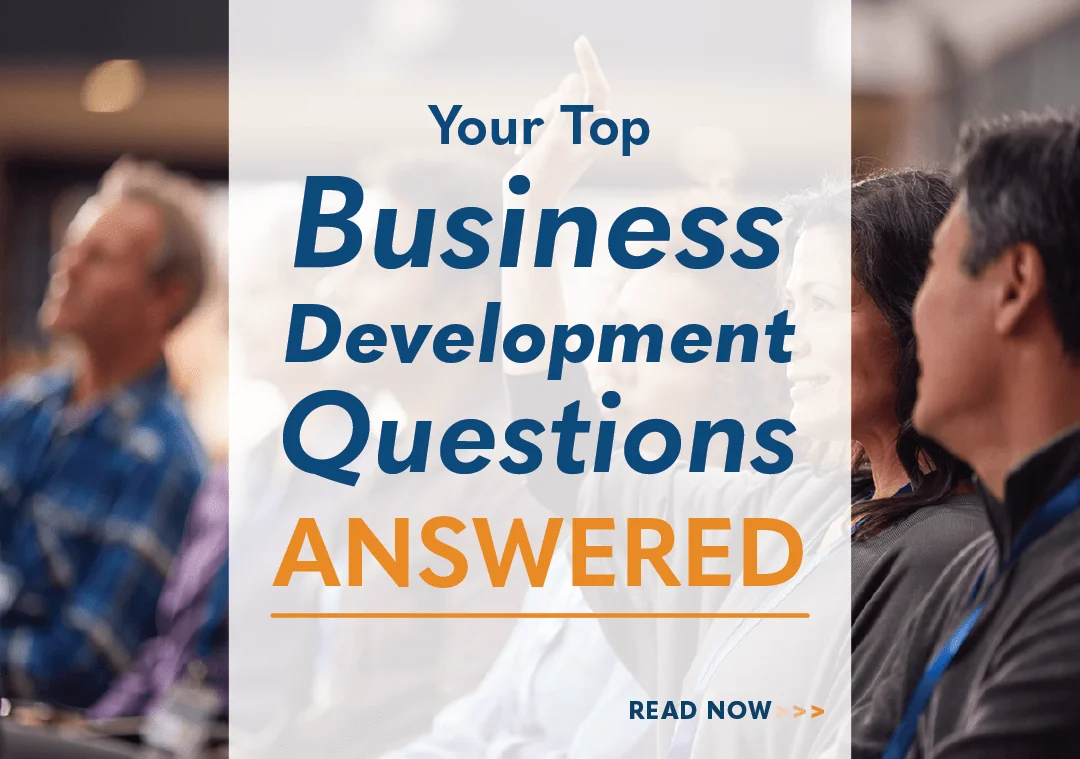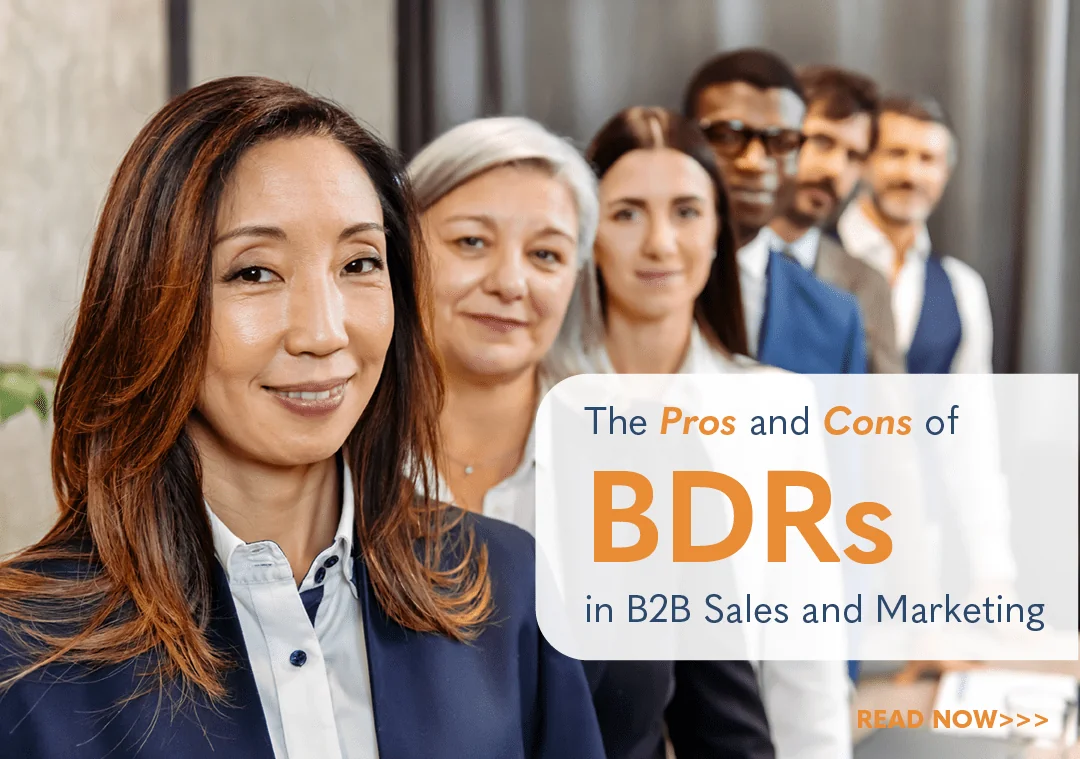Your Top Business Development Questions Answered

In B2B sales, business development is the activities and processes that promote growth and increase revenue. This includes boosting new business, enabling sellers to succeed, and providing customer value. As such, it is vital to long-term success and staying ahead of the competition.
Our recent webinar Turbocharging Business Development Strategies highlighted five key areas. These include creating buyer persons, utilizing BDRs, improving prospect qualification, measuring success, and implementing technology/AI. Following, our participants had questions. While our Q&A touched on answers, we wanted to dig deeper. Here, then, are more detailed answers and insights for the top questions from our webinar:
How do I create detailed and accurate buyer personas?
Buyer personas are a fundamental part of a business development strategy. A recent Janek poll revealed 83% of sales organizations utilize detailed buyer personas. And the more detailed, the better.
Start with your customers. Collect, review, and segment data from your CRM. For example:
- Employment info (titles, responsibilities, department)
- Demographics (age, education, gender, income, location)
- Psychographics (interests, values, goals, challenges, pain points)
- Technographics (social media, communication preferences)
- Objections (budgets, fear, lack of urgency)
Add details to personalize, such as names, visual representations, daily routines, etc. According to HubSpot, 96% of customers appreciate personalization. In addition, 94% of marketers say it increases sales. For more, see our blog Utilizing Buyer Personas in a Business Development Strategy.
Is there a set number of buyer personas?
It depends on your organization, industry, and customer type. Some companies may have as few as two and others as many as 10. Often, sales organizations have between three and five. However, data from Delv AI is interesting. They note three to four buyer personas account for over 90% of a company’s sales.
Therefore, more is not necessarily better. Let your customers be your guide. It’s best to start small. You can always add more as needed.
How do you determine a realistic ROI for BDRs?
This is a multifaceted metric. It is often based on various conversion rates and won opportunities related to your business development efforts. Consider:
- Leading or activity indicators, such as calls made, emails sent, meetings scheduled
- Benchmarking BDR performance against your organization’s historical data, perhaps from a period before a BDR team was established
- Conversion rates that measure lead-stage progression
- Revenue generated that can be directly attributed to the efforts of BDRs
Today, advances in technology, and specifically AI, can improve business development activities. This includes prospecting, lead generation, content marketing, and social selling—many activities supported by BDR teams. For example, Gartner’s Emerging Tech: Top Use Cases for Generative AI notes that, by 2025:
- 30% of larger organizations’ outbound marketing messages will be personalized with AI.
- 70% of digital marketing communications will be supported by AI avatars.
In addition, AI is showing immediate value increasing sales enablement (21%), content ideation (10%), and personalized marketing content (6%). As this can greatly support BDRs in business development, organizations need to invest in technology and AI.
For more, check out our blog Integrating Technology and AI Into Business Development.
What can be done to curb high BDR turnover?
According to the 2023 Sales Performance Scorecard by SalesMastery, BDRs have an 80% turnover rate. This is high by any measure.
In most organizations, BDRs are often seen as young and inexperienced. However, according to Zippia, the average age of a BDR is 43, with 59% over 40. Though they don’t say, it’s possible many have transitioned from other sales-related careers, such as customer service/support. And maybe they found the demands and quotas of business development more challenging.
Typically, to succeed, BDRs need the following:
- The right campaigns
- Appropriate involvement
- The right accounts and contacts
In addition, the 6Sense State of the BDR Survey notes what BDRs themselves say they need:
- 71% list better contact data.
- 70% want better intent data.
Providing these, organizations can improve a BDR’s drive and determination to succeed. Plus, sales training, coaching, and development are key. Remember, too, the more complex the BDR program, the less likely it is to succeed. Therefore, avoid overwhelming BDRs with goals, quotas, and compensation. Keep these simple.
What role does coaching play in keeping BDRs motivated?
Motivation is critical to BDR success. Therefore, consistent sales coaching is essential.
Today, BDRs face many challenges, in particular:
- Rejection
- Redundancy
- Lack of motivation
Unfortunately, rejection is part of selling. No one closes every deal. However, for BDRs, whose primary function is business development, it can become too much. This is especially true when you consider only 2% of cold calls lead to appointments.
In addition, there is a redundant aspect in a BDR’s daily activities. This includes researching leads, logging dozens of calls, and setting appointments. In this, it lacks the highs of “true” selling, including personal engagement, negotiation, and deal closing.
However, 6Sense notes support is essential. In 2022, 76% of BDRs felt more supported, resulting in quota attainment of 80%. However, in 2023, with only 64% of BDRs feeling supported, quota attainment fell to 61-70%.
What strategies drive leads through the funnel?
This depends on the prospect’s position in the funnel. Let’s look at each stage:
The top of the funnel is about generating awareness. This includes:
- Paid and organic searches
- Content/website optimization—a marketing term often called SEO (Search Engine Optimization) to rank higher in search engines
- Social selling
- Short-form content, like blogs
Middle funnel activities should be geared to a deeper level of engagement. This means thought leadership and increased knowledge of products/services, including:
- Events
- Podcasts
- Webinars
- Larger content, such as case studies and white papers
At the bottom of the funnel, consider more proactive outbound activities, including:
- Phone calls
- Appointment setting
- Lead handoff to sales
In this, organizations and especially BDRs must know where prospects are. Ultimately, their engagement should dictate the activities needed to guide them through the funnel.
What percentage of time should salespeople spend prospecting?
It depends on their sales responsibilities and if a dedicated BDR team can aid their prospecting efforts. For example, consider the following:
- Do they have account management and growth responsibilities?
- Are they tasked with expanding new business?
- Are these sellers primarily seen in a hunter role?
Depending on these considerations, the right mix can be as much as 20-40%. This includes true outbound (calls, emails, etc.), social selling, and LinkedIn activities.
Conclusion
As you can see, we had many insightful questions in our Q&A. We tried to answer each as fully as possible in the space allowed. But for more, be sure to check out our webinar Turbocharging Business Development Strategies here. In addition, please see our series of blogs referenced throughout.
- How do I create detailed and accurate buyer personas?
- Is there a set number of buyer personas?
- How do you determine a realistic ROI for BDRs?
- What can be done to curb high BDR turnover?
- What role does coaching play in keeping BDRs motivated?
- What strategies drive leads through the funnel?
- What percentage of time should salespeople spend prospecting?
- Conclusion

- Account Planning (11)
- Awards (50)
- Client Testimonial (37)
- Personal Branding (19)
- Podcast (11)
- Research (68)
- Sales Career Development (85)
- Sales Coaching (153)
- Sales Consulting (133)
- Sales Culture (164)
- Sales Enablement (340)
- Sales Leadership (108)
- Sales Management (242)
- Sales Negotiation (16)
- Sales Prospecting (124)
- Sales Role-Playing (18)
- Sales Training (229)
- Selling Strategies (255)
- Soft Skills (67)
- Talent Management (92)
- Trusted Advisor (27)
- Virtual Selling (41)
- Webinar (10)





























